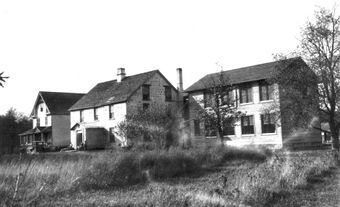Hearing Loss
Any person living in Canada, regardless of age, gender, ethnic background, geographic location, occupation, educational background or socio-economic status, can experience hearing loss. The social, emotional, educational and rehabilitative needs of these individuals can differ significantly, resulting in the need for diverse services, technological aids and programs.
Measures of Hearing
Hearing is measured in units called decibels (dB), which are used to indicate a sound's magnitude. For example, a spoken conversation is measured at an average of 60 dB, while ordinary city traffic is 80 dB. Hearing damage can occur after sustained exposure to sounds that are louder than 85 dB (such as sounds from lawnmowers, garbage trucks, and motorcycles). A typical rock band emits 110 dB of sound, enough to harm unprotected ears after 15 minutes (a temporary hearing loss may occur after being exposed for an extended period of time to sound at this level; permanent hearing loss can be a result of repeated exposure). The pain threshold (125 dB) is exceeded by jet engines and the discharge of shotguns. (See NOISE.)
When a person's hearing is tested (usually by an audiologist or audiometrist), the dB measurements are plotted on a graph to produce an audiogram (a "chart" of the person's hearing range). A person whose audiogram is within "normal" ranges can hear sounds that are no stronger than 25 dB. If stronger levels are needed for a person to detect a sound, then that person is said to have a hearing loss (however, technically, this term does not accurately describe a person who is born deaf and therefore has not had any hearing to "lose"). The term "hearing loss," then, is used as a blanket term to describe all degrees of decreased sensitivity to sound.
Terminology
The terminology used to describe people who have a hearing loss has come under scrutiny in recent years. Such words as hearing "impairment" and hearing "loss" are viewed with disfavour by those individuals who consider themselves to be culturally deaf (a specific linguistic group of individuals who identify themselves as being members of the Deaf Community) (see DEAF CULTURE). In print, the audiological condition of deafness and the cultural identification with Deaf culture are often differentiated by using "deaf" to indicate the former and "Deaf" to indicate the latter.
The medical professions distinguish different levels of hearing loss by specific terminology (mild, moderate, severe, profound), and believe each to have different consequences in a person's life. For example, a mild loss (0 to 30 dB) may have only a minimal effect on the person's ability to communicate through speech and auditory channels, while a profound loss (above 90 dB) may render sounds virtually inaccessible and communication through speech and auditory channels unlikely, if not impossible. Similarly, certain labels have been applied to people who experience different degrees of hearing loss (eg, a person who has a severe to profound loss is labelled deaf, while someone who has a mild to moderate hearing loss is usually called hard of hearing). These labels have changed over time. For example, in the 1800s and early 1900s a person who would now be identified as "deaf" was called a "mute," while a hard-of-hearing person was called a "semi-mute." (Such labels as "deaf and dumb" and "deaf-mute" are no longer acceptable.)
Hearing loss can be divided into two broad types: conductive and sensory-neural. The ear is divided into three parts: the outer, middle and inner ear. If hearing loss is caused by a condition that in some way blocks sound from getting through the outer and middle ear to the inner ear, that person is said to have a conductive hearing loss. Some conditions, however, affect the sensory cells within the inner ear. In this case the person is said to have a sensory hearing loss, which can affect both reception of a sound as well as understanding of a spoken message. Finally, if a condition affects the auditory nerve itself, the person is said to have a neural hearing loss. Because it is usually difficult to distinguish between sensory and neural hearing loss, the term "sensory-neural" hearing loss is often used. People with conductive hearing loss often benefit from hearing aids. However, people with sensory-neural hearing loss often do not benefit from these aids - while the sound itself is amplified (and therefore may be detected), it is often still muffled or distorted and thus not easily discriminated.
Hearing loss can be described as either prelingual (occurring before a person acquired a spoken language) or postlingual (occurring after a person has acquired a spoken language). These two terms are often misinterpreted to mean that a person's hearing loss can adversely affect the ability to acquire language in general, which is not the case (this is exhibited by those Deaf people who have acquired sign language as their most accessible language). It is in the areas of language acquisition and language choice that physicians, educators, parents of deaf and hard-of-hearing children, and the population of deaf people themselves have had the greatest debate (especially as language choice relates to the most efficacious method of educating deaf and hard-of-hearing children). Disagreements on this subject have existed for centuries and have been most evident in the educational philosophies applied to the education of deaf children. Proponents of the oral approach often completely forbid any use of sign language, while proponents of a manual approach encourage the use of sign language for instructional and communication purposes. These disagreements continue today.
Significant factors in determining the effect a hearing loss may have on a person's life include the measurement of hearing shown on the audiogram, the type of hearing loss and the age at which the person's hearing was affected. The decisions made by the family and the attitudes of the society in which the person resides also determine the effect of the hearing loss on the person's life.
Causes of Hearing Loss
Hearing can be affected at different times in a person's development and by different factors. A congenital ("at or before birth") hearing loss can occur from either genetic (ie, inherited) or environmental causes (eg, viral infections, especially the rubella virus and cytomegalovirus [CMV]); prematurity, especially with low birth weight; medications, drugs or alcohol ingested by the mother during pregnancy; injury during birth; oxygen deficiency, etc.). Causes of adventitious ("after birth") hearing loss can include exposure to noise in the environment; tumours; infections (especially of the middle ear [as in otitis media] or of the lining of the spinal cord and brain [as in spinal meningitis]); certain medications; malnutrition; injuries, especially head injuries; diseases such as diabetes mellitus, thyroid dysfunction, or renal and vascular diseases; and the aging process ("presbycusis"). Tinnitus ("ringing in the ears") also occurs with high frequency among older people.
Epidemics have had a significant influence on the incidence of hearing loss among Canadians. For example, during the 1950s and 1960s, outbreaks of rubella measles resulted in an increased number of children who were born with severe to profound hearing loss (as well as additional physical, cognitive and emotional conditions in some cases). This increase in the population of deaf and hard-of-hearing children, which resulted in the need for increase educational and service programs, is sometimes referred to as "the rubella bulge."
Vaccines developed to prevent similar epidemics have reduced the number of children whose deafness is a result of the rubella virus. However, other viruses (such as cytomegalovirus [CMV]) have taken its place. Many of these DISEASES also result in physical, emotional and cognitive conditions that can adversely affect a person's life. Thus, service providers are faced with a greater complexity of needs than was true in the past. Poverty, malnutrition and availability of health care can also have a significant impact on the numbers of people experiencing hearing loss. There is also a correlation between a person's age and their hearing status - an additional consideration for service providers, especially in determining the impact of hearing loss on both the individual and on society. As the number of older adults continues to increase (a result partly of improvements in health care - which has led to decreased age-specific mortality rates - and the "Baby Boom" of the 1940s and 1950s), so too does the incidence of hearing loss among the aged (see AGING).
Statistics
The number of Canadian residents who experience hearing loss is difficult to determine. Neither hearing testing nor the reporting of hearing tests is mandatory in Canada. To further complicate the issue, statisticians, the medical professions and demographers have disagreed over the years about the variables necessary to constitute inclusion in the different categories of hearing loss. From 1784 to 1951, the national census included questions on deafness, but the responses were anecdotal and varied depending on the individual informant's interpretation of a physical condition. Often census reports combined responses from deaf and blind people, which offered little insights into the actual number of Canadians affected by hearing loss. In 1983, the Canadian Health and Disability Survey began collecting information on people with a variety of disabilities, but again, the resulting reports often combined disabilities. However, many culturally Deaf Canadians do not consider themselves to be "disabled," and thus refuse to be included in a disability group survey. Despite the lack of statistics, most professionals who provide services to deaf, hard-of-hearing and deafened people do agree that the age at onset of the hearing loss is one of the most significant factors in determining an individual's educational, social, medical and rehabilitative needs.
Insight into deaf and hard-of-hearing children in Canada was most recently gained by a study conducted by researchers at McGill University in Montréal. During a ten-year span in the late 1970s and early 1980s an extensive demographic data base was developed on 8000 children. The report was published in 1987 as Study of Deaf Children in Canada. A separate report documented the data on deaf NATIVE Canadians living in the northern regions of the country.
Studies conducted in the US indicate that there is a positive association between age and hearing loss. A 1989 US report indicated that people over the age of 65 were seven times more likely to have a hearing loss than those under age 65. The possibility of experiencing hearing loss increases with age. Men are more likely than women to experience hearing problems, although the difference in numbers between the two genders decreases with age. The needs and concerns of elderly people who have been deaf most or all of their lives (and who have used sign language as their primary language) will differ considerably from those individuals who have experienced hearing loss for the first time in their senior years. For example, sign language interpreters may be beneficial to the former group but not to the latter.
Technology and Hearing Loss
Technology that can be of benefit to people with hearing loss includes assistive listening devices such as hearing aids, audio loops, FM systems and amplified telephone handsets; cochlear implants (which are considered inappropriate by many culturally Deaf individuals, especially when performed on young deaf children); visual or tactile alerting devices; closed-captioned television and videotaped programs, as well as real-time captioning of live events; TTYs (text telephones) and telephone relay services; and computerized note-taking for meetings and classrooms. Not all of this technology is appropriate for or desired by every person who has a hearing loss, however.
Impact on the Individual and on Society
The services required to meet the needs and concerns of deaf, hard-of-hearing, early-deafened, late-deafened and those elderly individuals who have been Deaf for all or most of their lives differ significantly. For example, US studies have shown that the elderly population who experience hearing loss also experience greater limitations in their usual activities than do elderly people without hearing loss. Debate over the best approach to the education of deaf children will continue to be of concern as research sheds more light on language acquisition and learning. The impact of environmental factors (such as noise, disease and head injury) on hearing loss also must be addressed. Societal attitudes toward people with hearing loss and the personal impact that hearing loss has on the individual are also areas of concern. All of these factors put additional pressures on the training and funding of the individuals and organizations that provide services to Canadians experiencing hearing loss.

 Share on Facebook
Share on Facebook Share on X
Share on X Share by Email
Share by Email Share on Google Classroom
Share on Google Classroom


